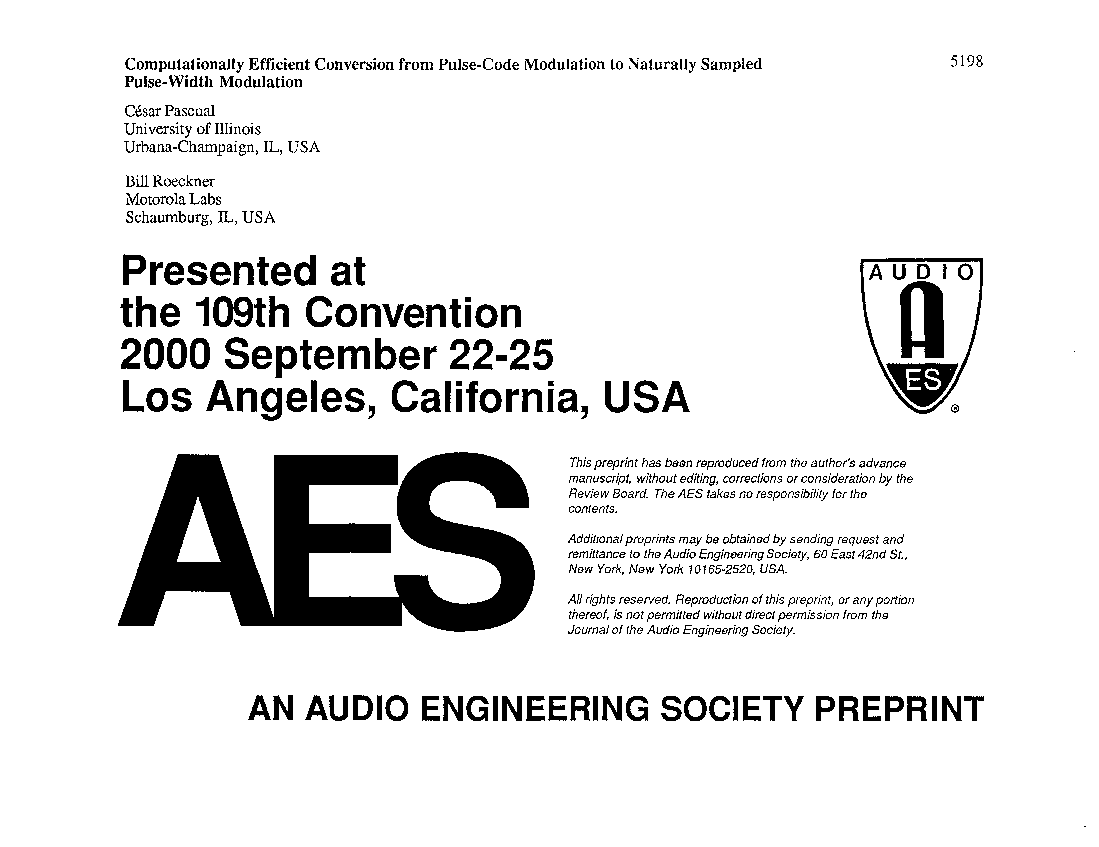Home / Publications / E-library page
You are currently logged in as an
Institutional Subscriber.
If you would like to logout,
please click on the button below.
Home / Publications / E-library page
Only AES members and Institutional Journal Subscribers can download
This paper describes two new algorithms to convert a uniformly sampled sequence into a naturally sampled pulse-width modulation (NPWM) signal. They are suitable for both single- and double-edge NPWM. Single-edge algorithm A requires nine additions and seven multiplications per output sample and achieves a total harmonic distortion (THD) of -88.48 dB when the input signal is a 6.66-kHz tone upsampled 8 times. Single-edge algorithm B requires 14 additions, 11 multiplications, and one comparison per output sample and yields -113.07 dB of THD under the same conditions. Intermodulation distortion is very low for both algorithms. Polynomial interpolation methods with the same degree of accuracy are computationally more expensive. The algorithms have enabled the implementation of digital audio amplifiers performing efficient real-time digital signal processing.:
Author (s): Pascual, César; Roeckner, Bill
Affiliation:
University of Illinois, Urbana-Champaign, IL ; Motorola Labs, Schaumburg, IL
(See document for exact affiliation information.)
AES Convention: 109
Paper Number:5198
Publication Date:
2000-09-06
Import into BibTeX
Session subject:
Analog Signal Processing
Permalink: https://aes2.org/publications/elibrary-page/?id=9140
(554KB)
Click to purchase paper as a non-member or login as an AES member. If your company or school subscribes to the E-Library then switch to the institutional version. If you are not an AES member Join the AES. If you need to check your member status, login to the Member Portal.

Pascual, César; Roeckner, Bill; 2000; Computationally Efficient Conversion from Pulse-Code Modulation to Naturally Sampled Pulse-Width Modulation [PDF]; University of Illinois, Urbana-Champaign, IL ; Motorola Labs, Schaumburg, IL; Paper 5198; Available from: https://aes2.org/publications/elibrary-page/?id=9140
Pascual, César; Roeckner, Bill; Computationally Efficient Conversion from Pulse-Code Modulation to Naturally Sampled Pulse-Width Modulation [PDF]; University of Illinois, Urbana-Champaign, IL ; Motorola Labs, Schaumburg, IL; Paper 5198; 2000 Available: https://aes2.org/publications/elibrary-page/?id=9140
@article{pascual2000computationally,
author={pascual césar and roeckner bill},
journal={journal of the audio engineering society},
title={computationally efficient conversion from pulse-code modulation to naturally sampled pulse-width modulation},
year={2000},
number={5198},
month={september},}